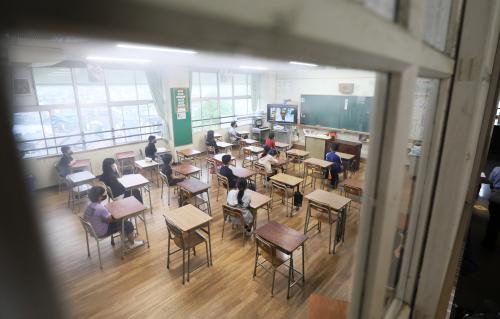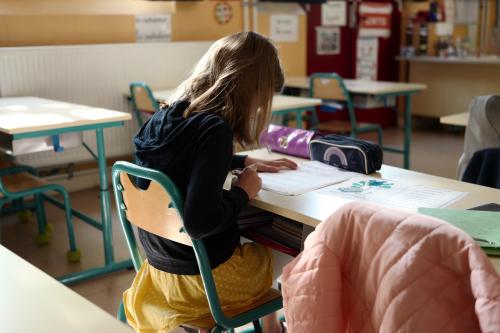We are experiencing an extraordinary global crisis with devastating impacts that will be felt for generations. At the height of the pandemic, nearly 1.6 billion children and youth—more than 90 percent of the world’s student population—had their education disrupted due to school and university closures in more than 190 countries. Sixty-three million teachers, the wider education workforce, communities, and parents are all grappling with ways to ensure that learning does not stop.
We cannot neglect education in this crisis
While global attention is focused on urgent health needs and social protection, the international community must be proactive in safeguarding other sectors as well to help mitigate the long-term damage from the crisis, especially to the poorest and most vulnerable populations. Crucially, we cannot lose sight of education, which will be adversely affected both by the pandemic itself—due to widespread, prolonged school closures—and the associated financial crisis, which will squeeze government budgets. These challenges will further exacerbate the global learning crisis that was already threatening the livelihoods of tens of millions of children before the onset of the pandemic.
Given that education is an essential catalyst for progress on all development goals—especially poverty reduction, health, gender equality, and climate—lapses in learning and funding will have far-reaching social and economic repercussions.
Previous crises offer some insight, but the scale of this crisis is unprecedented
Assessment of the 2008 economic crisis found that vulnerable groups were disproportionately affected, as poor families were more likely to take their children out of school, either to put them to work or because it was no longer affordable. Some governments raised school fees to compensate for declining budgetary resources, creating additional financial burdens on families when they could least afford it. The depth of the current economic crisis is still unknown but initial indications are dire. The World Bank estimates that low- and middle-income countries could cut between $100 to $150 billion out of their 2021 education budgets and this generation stands to lose $10 trillion in lost income. The Malala Fund estimates 10 million more secondary school girls could drop out of school due to the pandemic.
Significant, additional resources will be needed to protect education and long-term development prospects.
IFFEd is a cost-effective, innovative lifeline for education financing
The International Finance Facility for Education (IFFEd) is a new, cost-effective mechanism to support education finance that will soon be open for business and help protect education funding in the current crisis. It will enable lower-middle-income countries (LMICs) to access a new stream of affordable financing to protect education spending without trading off against other vital priorities, like health. It will also use existing established channels of development funding to LMICs—the multilateral development banks (MDBs)—and not place additional administrative burdens on developing countries. Because IFFEd was designed to operate efficiently and leverage scarce donor and MDB resources, it is ideally suited to serve as a crisis response instrument. The decision to work through established organizations with decades of experience in education delivery means that resources will be swiftly and effectively deployed.
Using contingent and cash contributions from donors, IFFEd will help with the supply of affordable education financing provided by MDBs, which will design and implement all IFFEd programs. IFFEd will guarantee a share of loan repayments by LMICs from the MDBs, effectively providing quasi-equity that the MDBs can leverage four times on capital markets. This increase in the MDBs’ lending capacity comes at very low cost to donors, who will pay only 15 cents in cash for each dollar contributed. This means that LMICs will have additional resource allocations—above and beyond what they would receive from MDBs without IFFEd—to support their education budgets.
For IFFEd’s guarantees to serve as quasi-equity, they must fulfill certain properties that replicate those of regular MDB paid-in capital. First, the IFFEd guarantees must be long-term to underpin additional loans that the participating MDBs will offer to eligible borrowers (e.g., with average maturities of some 18 years). Second, the guarantees will be applied to a portfolio of loans, not to any individual loan. Third, the guarantees must be backed by a strongly rated independent entity (i.e., IFFEd) that will very likely maintain that rating over the long term. Fourth, the entity must be able to meet its obligations on a timely basis and not be subject to donor political and administrative complications. And finally, to reassure MDBs and rating agencies, the entity needs to be financially viable, able to meet annual administrative and financial costs from self-generated resources.
To this end, IFFEd is being established as an independent financial entity in the U.K. with the following financial structure: As “assets,” IFFEd will provide long-term guarantees (21 years) to the eligible portfolios of the MDBs, charging a risk-based fee per dollar guaranteed that, together with interest earnings, will generate revenue to meet IFFEd’s small administrative costs and possible losses. As “liabilities,” IFFEd will be endowed with paid-in cash and contingent obligations from contributors. To reassure the rating agencies and the MDBs, the value of IFFEd’s guarantees will not exceed the sum of Ccontributor commitments, cash, and contingent.
The amount of paid-in cash and the properties of the contingent obligations have been designed to maintain and secure a strong rating while maximizing its value for money. Given the strong repayment history of MDBs and that IFFEd’s guarantee portfolio will be very diversified (the sum of the covered portfolios of all the participating MDBs), the paid-in portion of IFFEd’s “capital” will only be 15 percent, as noted above. Contributors have legally binding obligations to increase their paid-in share if IFFEd’s capitalization falls below safe margins or if contributors (all highly rated sovereigns) are downgraded. This will enable MDBs to leverage IFFEd’s portfolio guarantees four times, close to the leverage secured from their own paid-in capital (IBRD, for example, leverages its paid in capital at most five times). Hence, donor cash contributions of 15 cents will deliver $4 of education services in eligible countries.
To ensure that these additional resources support education, IFFEd will issue guarantees only when MDBs sign an eligible education loan with a developing country. The guarantee would equal the loan amount divided by the leverage ratio. For example, an eligible education loan of $200 million would generate $50 million of portfolio guarantees given a leverage ratio of four.
IFFEd is focusing on the demand side of education financing
IFFEd also includes measures to increase the demand for and effectiveness of the education financing by improving the terms of the financing and focusing on the neediest population.
Regarding financing, IFFEd will request eligible countries to commit to increases in domestic resources allocated to education, or if education is already funded adequately, countries will need to commit to maintain spending at that level. These domestic resource targets will have to be carefully calibrated to consider the impact of COVID-19 on domestic resource mobilization targets.
In addition, IFFEd will have a grant window to subsidize the cost of education financing, just as other sources of affordable financing are drying up. This will make it easier for finance ministers to justify protecting education budgets and even increase them if required both during the crisis and when economic conditions improve.
Critically, IFFEd programs will also target the most at-risk populations, including girls, the disabled, and the forcibly displaced. Providing them access to schooling will in turn reinforce the virtuous cycle associated with learning, especially for girls—reduced poverty, better health outcomes, and reduced maternal and child mortality. These benefits have exponentially positive impacts: A child whose mother can read is 50 percent more likely to live past the age of 5, 5 percent more likely to be immunized, and twice as likely to attend school, all of which lead to better lives for the next generation.
IFFEd will also focus on LMICs that even before the crisis faced exceptional challenges in improving learning outcomes. LMICs are home to almost half of the world’s children and youth (a total of 700 million), have the most children out of school (over 150 million), and host half of all refugees and displaced youth. Worryingly, according to the Education Commission, 550 million children and youth in LMICs are not on track to learn the necessary skills needed to thrive or even participate in the workforce. The situation is particularly dire for LMICs in sub-Saharan Africa and South Asia, where over 80 percent of the current school-age population is not on track to reach secondary learning benchmarks. There are important implications for gender equality as well: Two LMICs—Angola and Nigeria—are listed among the five countries with the largest gender gaps in primary education.
LMICs are likely to be hit particularly hard by the COVID-19 crisis. Even before the pandemic, they faced chronic funding shortfalls in education and were projected to account for nearly 80 percent (more than $70 billion annually) of the global shortfall in international funding by 2030. LMICs are vulnerable to external shocks, due to their increasing reliance on external, volatile private sources of finance, greater on average than low-income countries which rely more on grants and concessional finance from donors. LMICs are likely to face steep declines in public revenues due to falls in commodity exports, tourism, and remittances. Declining revenues will coincide with escalating spending needs and, in some countries, increased borrowing costs. Unlike advanced and some upper-middle-income countries, LMICs cannot mount strong fiscal responses on their own. As a result, demand for official development finance from MDBs and others is escalating sharply.
IFFEd is in line with growing calls for exceptional financing terms because it will give LMICs fiscal space to respond to the crisis. Specifically, given today’s interest rates and combined with IFFEd’s grant window, LMICs will be able to borrow at terms usually reserved for lower-income countries. And, with initial grace periods of five years or longer, finance ministers will not need to service these loans at all during the current crisis. The terms and volumes for IFFEd-supported education programs will also need to be fully consistent with each country’s debt sustainability framework to ensure that the additional borrowing does not contribute to risks of debt distress.
IFFEd is ready to launch
A group of leading contributors and the MDBs have concluded IFFEd’s design and legal structure, and the credit rating agencies have issued strong, positive assessments. Results and risk management frameworks, as well as a set of robust eligibility criteria, have been developed. The OECD’s Development Co-operation Directorate has confirmed recognition of IFFEd as a fully-ODA eligible organization, and the Netherlands, U.K., and European Commission have pledged initial contributions. IFFEd will be ready to open its office in London soon. However, for IFFEd to meet its significant potential for meaningful, systemic impact in countries at risk of reversing years of progress in education, it is imperative that donors step up with additional resources as soon as possible.
The Brookings Institution is committed to quality, independence, and impact.
We are supported by a diverse array of funders. In line with our values and policies, each Brookings publication represents the sole views of its author(s).










Commentary
The International Finance Facility for Education: A vital instrument to mitigate the impact of the pandemic
July 9, 2020